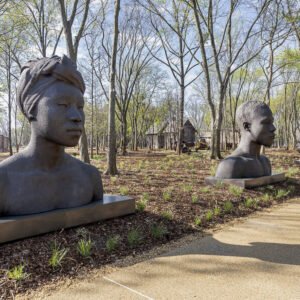How should the story of slavery in the United States be told?
In Montgomery, Alabama – once a major trafficking port for enslaved people – a new 17-acre park with a focus on art is attracting thousands of visitors. Freedom Monument Sculpture Park, opened in late March, features bronze sculptures and historical artifacts that highlight what life was like for enslaved people. The park culminates in the four-story National Monument to Freedom, inscribed with 122,000 last names that formerly enslaved people chose for themselves after being emancipated.
The sculpture park is the third Legacy Site created by the Equal Justice Initiative, a legal advocacy organization started by Bryan Stevenson, a lawyer perhaps best known for his memoir and the 2019 movie based on it, “Just Mercy.”
In a recent video call with the Monitor, Mr. Stevenson shared that he traveled to plantations during the pandemic, and it made him think about the need for a different kind of space – one to join the organization’s Legacy Museum and National Memorial for Peace and Justice. “When you experience all three,” he says, “you leave with a much deeper understanding of our nation, and the continuing obligation, the need, to advance justice and equality and liberty for all people.” The conversation with Mr. Stevenson has been edited for length and clarity.
What do you feel the park adds to the conversation about slavery and race in the U.S.?
I don’t think there have been places where people could go and have an honest engagement with the history of slavery in America. Most of the places that exist are plantations, which are just architecturally built around the lives of the people who enslaved. The big house, the mansion, the gardens, the horticulture – is all really organized around celebrating the grandeur and the wealth of these families that profited from forced labor. And very little is done to really explore the lives of enslaved people, to think about slavery through their perspective.
The park that we’ve created really tries to remedy that. It’s a space where you are presented with the history of slavery by focusing on the lives of enslaved people. How did they cope with so much violence and abuse and degradation? How did they endure? How did they survive? How did they love in the face of so much uncertainty and brutality? And we talk about that in all aspects – the trafficking, the separation, the housing, the multiple challenges that people faced. And so it’s a deep dive into the legacy and the institution of slavery that I think is unique in the American landscape.
